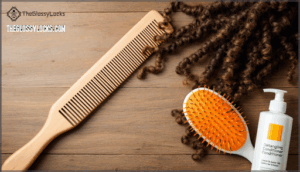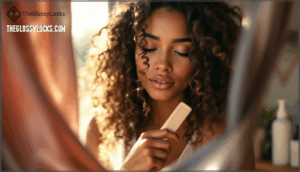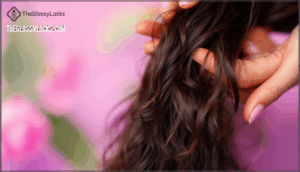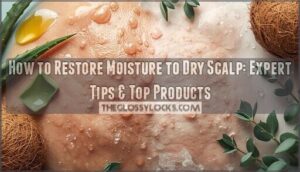This site is supported by our readers. We may earn a commission, at no cost to you, if you purchase through links.
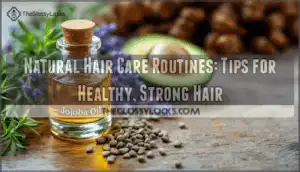 Your hair follicles have been following the same genetic blueprint for thousands of years, yet somewhere along the way, we convinced ourselves that healthy hair requires a chemistry lab’s worth of synthetic ingredients. The truth is simpler: your scalp evolved to maintain hair health through its own sebum production and natural moisture balance.
Your hair follicles have been following the same genetic blueprint for thousands of years, yet somewhere along the way, we convinced ourselves that healthy hair requires a chemistry lab’s worth of synthetic ingredients. The truth is simpler: your scalp evolved to maintain hair health through its own sebum production and natural moisture balance.
When you strip away harsh sulfates and silicones, you’re not depriving your hair—you’re letting it function the way it was designed to. Natural hair care routines work with your biology instead of against it, using plant-based oils and gentle techniques that mirror what your body already does.
The shift requires patience as your scalp recalibrates, but once you understand your specific hair type and porosity, you can build a routine that delivers stronger strands without the chemical overwhelm.
Table Of Contents
- Key Takeaways
- Natural Hair Care Basics
- Daily and Weekly Hair Care Practices
- Nourishing and Moisturizing Your Hair
- Detangling, Styling, and Hair Protection
- Supporting Healthy Hair Growth
- Frequently Asked Questions (FAQs)
- What is a good hair care routine for natural hair?
- What should be a healthy hair care routine?
- What should I do to my natural hair daily?
- What is the best natural hair care routine?
- How can I take care of my natural hair naturally?
- How to take care of your hair naturally?
- What is the best routine for healthy hair?
- How can I prevent hair shrinkage naturally?
- What are effective remedies for scalp itchiness?
- How do I manage postpartum hair shedding?
- Conclusion
Key Takeaways
- Your scalp naturally produces sebum and maintains moisture balance on its own, so stripping it with harsh sulfates and silicones actually works against your hair’s built-in health system rather than supporting it.
- Washing natural hair once a week (or every 7-14 days) preserves your scalp’s oil balance and moisture retention better than frequent washing, especially for coarser textures that benefit from natural sebum distribution.
- Regular scalp massage with vegetable oils like rosemary or coconut boosts blood flow to follicles by 10-15%, with studies showing 70% of participants noticed hair regrowth after six months of daily practice.
- Hair porosity determines how you should moisturize—high-porosity hair loses hydration 2-3 times faster and needs weekly protein treatments, while sealing damp hair with oils within five minutes can boost moisture retention by up to 30%.
Natural Hair Care Basics
Before you commit to a natural hair care routine, you need to understand what you’re working with. Your hair type, texture, porosity, and density all affect how you should care for it.
Let’s break down the basics so you can build a routine that actually works.
Identifying Your Hair Type and Texture
Why does your hair behave the way it does? Understanding your hair type and texture is the foundation of effective natural hair care. Hair type refers to your curl pattern—straight, wavy, curly, or coily—while hair texture describes strand thickness. Knowing these characteristics helps in choosing the right products and treatments.
Here’s what shapes them:
- Follicle shape: Circular follicles create straight hair; oval ones produce curly hair
- Genetics: Your DNA controls about 85–90% of your curl pattern
- Environmental impact: Humidity can temporarily alter your texture by up to 20%
Simple DIY tests help you identify your natural state. Wash your hair without products, let it air dry, then compare it to hair typing systems like the Andre Walker chart.
Understanding Hair Porosity and Density
Once you know your type and texture, you can dig deeper into porosity and density—two factors that shape how your hair absorbs moisture and holds up over time. Hair porosity measures how easily your strands take in water and oil, while hair density counts how many hair strands fill each square centimeter of your scalp. Chemical treatments and environmental damage can raise porosity, weakening structure.
Understanding both helps you build an individualized hair care routine that balances hydration and strength. To achieve the best results, consider learning about hair care basics to customize your approach.
Why Choose a Natural Hair Care Routine
Choosing natural hair care means protecting your scalp from sulfates, parabens, and phthalates that dry out strands and trigger irritation. You’ll reduce exposure to VOCs and endocrine disruptors while supporting scalp health with plant-based nutrients.
Here’s why it matters:
- Chemical-Free formulas lower your risk of scalp inflammation and long-term toxin buildup
- Natural Ingredients like oils deliver vitamins and antioxidants that strengthen follicles and boost Hair Growth
- Eco Friendly packaging and biodegradable formulas support Sustainable Beauty without harming waterways
A natural Hair Care Routine builds Hair Wellness from the inside out, giving you healthier Natural Hair without compromise.
Daily and Weekly Hair Care Practices
Your wash-and-care schedule shapes how your hair looks and feels every day. The sweet spot between too much washing and not enough comes down to your hair’s natural oil production and your lifestyle.
Let’s break down the practical strategies that keep long, straight hair healthy without overcomplicating your routine.
How Often to Wash Natural Hair
Most dermatologists agree that washing once a week works well for natural hair care. The American Academy of Dermatology suggests washing every seven to 14 days to maintain scalp health and moisture retention.
Your hair oil balance and texture matter more than your workout schedule when planning your wash and condition routine. If you have coarser hair, stretching to biweekly cleansing helps preserve natural oils while supporting hair health through gentle, less frequent natural cleansing.
Cleansing Techniques for Long, Straight Hair
Long straight hair demands a strategy that respects its journey from scalp to ends. Start by sectioning your hair into manageable parts—this cuts down tangling during your hair cleansing and care routine.
Apply Shampoo Frequency that suits your scalp, focusing only on roots where oil accumulates. Gentle Rinsing with lukewarm water between 35–38°C removes cleanser without damaging keratin.
A brief Scalp Massage with fingertips boosts circulation by 10–15%, supporting Oil Benefits and follicle health while distributing sebum evenly down your long hair shafts for natural shine and reduced Hair Porosity concerns.
Using Dry Shampoo and Braiding Between Washes
Between washes, you can lean on dry shampoo or braiding to extend cleanliness without stripping your scalp. Experts suggest limiting dry shampoo to once or twice weekly—overuse triggers product buildup, dandruff, and breakage from alcohol-based formulas.
Here’s your game plan for Hair Revitalization and Scalp Hygiene:
- Spray 6–8 inches from roots to prevent pore blockage and scalp inflammation
- Massage product through to absorb oil and boost volume without visible residue
- Braid overnight to lock in moisture, reduce tangling, and minimize friction damage
- Alternate methods weekly—dry shampoo one day, protective hairstyles the next
- Deep cleanse regularly to clear buildup and maintain hair growth momentum
Braiding techniques like knotless styles reduce tension while keeping natural hair protected between full washes.
Nourishing and Moisturizing Your Hair
Your hair needs moisture and nourishment to stay strong and healthy, especially when you’re growing it long.
The right oils and techniques can make a real difference in how your hair looks and feels. Here’s what works to keep your strands hydrated and thriving.
Benefits of Vegetable Oil Scalp Massage
Massaging vegetable oil into your scalp does more than feel good—it actually kickstarts better hair growth. A 2025 review found that regular scalp massage boosts blood flow, delivering oxygen and nutrients straight to your follicles.
This means healthier roots and potentially thicker hair over time. The massage itself helps reduce shedding after consistent practice, while oils like coconut and olive penetrate deep to hydrate and strengthen each strand from within.
Choosing Oils for Growth and Shine
Not all oils work the same way—some stimulate growth, while others focus on shine. Rosemary oil matched minoxidil’s performance in clinical trials, boosting hair count by 28.6%. Coconut oil reduced protein loss by 39%, and argan oil increased elasticity by 23% in just four weeks.
Here’s what different natural oils bring to the table:
- Rosemary and pumpkin seed oil target growth factors and scalp health through ayurvedic oil treatment principles
- Coconut oil penetrates deep for hair nourishment and prevents breakage with its lauric acid content
- Argan and jojoba oil deliver serious hair shine while mimicking your natural sebum
- Grape seed oil improves microcirculation, supporting hair regeneration through natural remedies
Pick oils based on your goal—growth, protection, or gloss—and you’ll see real oil benefits.
Moisturizing and Sealing Methods
Think of moisturizing as feeding your hair water, then locking it in—that’s where sealing techniques come in. Apply moisturizing products with humectant benefits like glycerin or leave-in conditioner when your hair’s still damp. Follow with occlusive agents—oils that trap moisture inside. This method boosts moisture retention by up to 30%, especially if you seal within five minutes.
Your hair porosity determines whether you need lighter or heavier products to maintain hair moisture effectively.
Cold Water Rinsing and Its Advantages
Cold water rinsing seals your hair cuticle, locking in moisture and boosting shine—it’s one of the simplest upgrades to your hair care routine. Here’s what this finishing step does for natural hair health and wellness:
- Hair Cuticle Sealing – Flattens the outer layer, reflecting more light for visible shine
- Moisture Retention – Preserves scalp oils and reduces water loss by 10–15%
- Frizz Reduction – Lowers static charge by up to 20%, smoothing texture
- Scalp Stimulation – Increases microcirculation by 5–7%, supporting follicle health
This quick trick improves your hair cleansing process and enhances hair moisturizing techniques without extra products.
Detangling, Styling, and Hair Protection
Once your hair is clean and moisturized, you’ll need to handle it carefully to keep it strong and looking its best. The way you detangle, dry, and style makes a real difference in preventing damage.
Here’s what works to protect those long strands while keeping your routine simple.
Proper Detangling Tools and Techniques
Your hair detangling process deserves the right tools and techniques to minimize breakage. Always detangle gently from ends to roots—this method cuts breakage by up to 60%. Moisturized hair shows 25% higher elasticity, so condition before you start. Over-detangling (more than three times weekly) causes cuticle wear in 79% of cases, so pace your hair care routine wisely.
Wide-tooth combs create 30% less stress on strands than fine-tooth combs, while detangle brushes with flexible bristles reduce breakage by 22%. Finger detangling in conditioner maintains natural curl clusters.
Wet detangling with slip-enhancing products reduces breakage by 75% compared to dry methods for most natural hair types. Section your hair into four parts for even tension distribution and 40% fewer tangles. Some natural hair care routine enthusiasts also use silicone scalp massagers during conditioning to boost circulation while preparing strands for gentle manipulation.
| Detangling Methods | Best For | Key Benefit |
|---|---|---|
| Wide-tooth hair combs | All hair types | 30% less tensile stress |
| Flexible detangle brushes | Thick, coarse hair | 22% lower breakage rates |
| Finger detangling | Natural curls | Preserves curl pattern |
Air Drying Vs. Blow Drying
Once your hair is detangled, deciding how to dry it matters for hair health. Air drying seems gentle, but prolonged moisture retention can weaken internal bonds and increase hair breakage by straining the cuticle.
Blow drying at 47°C from 15 cm distance actually causes less hair damage than air drying, according to electron microscopy studies. Keep the dryer moving, use medium heat for thermal protection, and finish with cool air to lock moisture retention without compromising your natural hair care routine.
Protective Styles for Long Hair
Protective styling is your long-haul strategy for keeping hair healthy. Braids, twists, and updos cut breakage rates by up to 35% when you keep them in for four to eight weeks.
Box braids and knotless braids are top picks—they distribute tension evenly and shield strands from daily manipulation.
Wigs and faux locs also work well, locking in moisture while your natural hair rests underneath.
Minimizing Breakage and Frizz
Breakage and frizz are two sides of the same coin—both signal moisture imbalance and mechanical stress. When you strip natural oils through excess shampooing or skip heat protection, you’re asking for trouble. Controlled-use shampoos and thermal protectants cut breakage by 25–35% while preserving hair elasticity and scalp health.
Here’s your breakage prevention and frizz control toolkit:
- Detangle only when conditioned—slip agents reduce combing force by 40% and prevent micro-tears along the shaft
- Switch to silk or satin pillowcases—they slash overnight friction by 43%, locking in moisture balance
- Air dry whenever possible—you’ll lose 2.3 times less internal moisture compared to high-heat blow drying
These hair strengthening moves keep your strands flexible and smooth, giving you real frizz reduction without complicated routines.
Supporting Healthy Hair Growth
Growing healthy hair isn’t just about what you put on it—it starts from within. Your scalp, diet, and daily habits all play a major role in how strong and vibrant your hair becomes.
Let’s look at three key areas that support natural growth and keep your hair thriving over time.
Scalp Health and Massage Benefits
Think of your scalp as soil—healthy roots need the right environment to thrive. Regular scalp massage boosts blood flow to follicles, and studies show 70% of participants noticed hair regrowth after six months of daily practice.
Scalp therapy also reduces cortisol levels, dropping stress hormones that contribute to shedding. Adding oils like rosemary or lavender during massage promotes microbiome balance and scalp health.
These simple scalp care habits strengthen natural hair care routines from the foundation up.
Diet, Hydration, and Sleep for Hair Health
Beyond what you eat, how you live directly impacts hair health. Studies show that higher vitamin D levels correlate with lower alopecia rates, while protein intake above 0.8 g/kg daily boosts anagen-to-telogen ratios by 28%.
Scalp hydration matters too—drinking 2.5 liters of water daily improved scalp elasticity by 19%. Sleep quality promotes natural hair growth; consistent 7–8 hour nights increase nocturnal scalp blood flow.
A balanced diet, proper hydration, and solid sleep reduce shedding by 35% over six months.
Adapting Your Routine for Changing Hair Needs
Your hair won’t stay the same forever—hormonal shifts, aging, and environmental exposure all reshape texture, density, and moisture needs. Seasonal adjustments and product shifting keep your hair care routine aligned with what your natural hair actually requires right now.
Restoring integrity means listening to your hair and adjusting as it evolves.
- Moisture Balance: High-porosity hair loses hydration 2–3 times faster, so rotate protein and moisturizing treatments weekly
- Protein Needs: Bi-weekly masks improve tensile strength by 25%, restoring integrity after heat or chemical stress
- Seasonal care: Switch to chelating shampoos monthly to remove mineral buildup and preserve shine
- Lighter oils: Swap heavier oils for jojoba or grapeseed in summer to prevent sebum imbalance
Frequently Asked Questions (FAQs)
What is a good hair care routine for natural hair?
A solid hair care routine starts with knowing your hair’s unique needs—its type, porosity, and density shape how you moisturize, cleanse, and protect it.
Wash once or twice weekly, nourish with oils, detangle gently, and let lifestyle factors guide seasonal adjustments and product selection for lasting hair health.
What should be a healthy hair care routine?
Like a plant that thrives on the right mix of sun, water, and soil, your hair flourishes with a balanced approach. A healthy hair care routine combines consistent product selection, damage prevention through gentle handling, and seasonal adjustments as your needs shift.
Your hair thrives on balance—choosing the right products, handling strands gently, and adjusting seasonally creates lasting health
Choose natural hair products that suit your texture, stick to a regimen you can maintain, and customize it as you learn what works best.
What should I do to my natural hair daily?
Daily hydration practices, scalp massage, and protective styling form your natural hair care routine foundation.
Apply lightweight products, shield strands from environmental damage, and prioritize gentle handling.
These healthy hair maintenance habits support growth while minimizing breakage throughout your hair health journey.
What is the best natural hair care routine?
Your best natural hair care routine balances scalp health with hair-type customization. Focus on washing weekly, massaging oils into your scalp, using targeted products, adjusting seasonally, and maintaining hydration through water-rich foods and proper sleep for ideal hair health.
How can I take care of my natural hair naturally?
Natural oils like coconut, jojoba, and olive offer deep moisture through scalp massage, improving circulation and reducing protein loss. Cold water rinses seal the cuticle for added shine.
DIY hair masks with natural humectants like honey boost hydration, while scalp exfoliation removes buildup, supporting a healthy hair routine.
How to take care of your hair naturally?
You can care for your hair naturally by using gentle cleansing methods, massaging natural oils like coconut or castor into your scalp, and maintaining a consistent hair routine.
Focus on hydration importance through water-based products and DIY masks with natural ingredients.
Supporting overall hair health requires a proper diet and sleep.
What is the best routine for healthy hair?
Your hair health and wellness depend on a Healthy hair routine suited to your needs. Start with weekly cleansing, oil-based scalp massage, and gentle detangling.
Factor in Seasonal Adjustments, Lifestyle Impacts, and Professional Consultations to improve your natural hair approach through thoughtful Product Selection and Routine Customization.
How can I prevent hair shrinkage naturally?
Ironically, keeping natural hair stretched often means working against its nature. Minimize shrinkage through humectant balance in moderate humidity, protein treatments every 4-6 weeks, and pH rinses like apple cider vinegar to tighten cuticles and extend style longevity.
What are effective remedies for scalp itchiness?
Scalp itchiness often stems from dandruff, with solutions like anti-fungal shampoos, oil treatments for dryness, or avoiding product allergies. Regular scalp massage boosts circulation, while dietary impact—especially hydration—promotes scalp health and care.
Natural hair treatment focuses on gentle, consistent scalp care.
How do I manage postpartum hair shedding?
Think of it like a sudden season change—your hair is simply recalibrating after pregnancy’s hormonal fluctuations. Nutritional deficiencies can worsen hair shedding, so focus on iron and biotin.
Gentle routines minimize breakage, while topical treatments like minoxidil support hair growth.
If hair loss persists beyond six months, seek professional advice for underlying hair health concerns.
Conclusion
Stronger strands start with simpler strategies. When you stop stripping your scalp with synthetic solutions and start supporting its natural sebum cycle, your hair responds with resilience.
Natural hair care routines aren’t about adding more products—they’re about removing the interference. Trust your follicles to do what they’ve always done best: grow, strengthen, and shine.
The chemistry was already perfect; you just needed to stop fighting it.
- https://en.wikipedia.org/wiki/Andre_Walker_Hair_Typing_System
- https://www.laylakays.com/pages/textured-tresses-worldwide-celebrating-the-global-diversity-of-hair
- https://pmc.ncbi.nlm.nih.gov/articles/PMC10914121/
- https://pubmed.ncbi.nlm.nih.gov/37212612/
- https://www.onychair.com/different-types-of-hair-textures-natural-hair-types/



